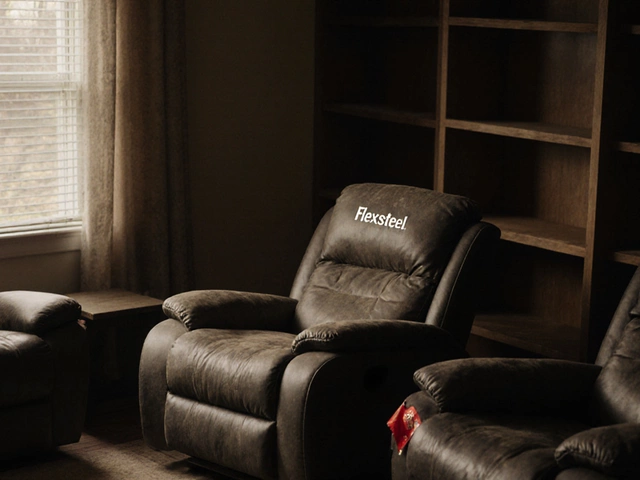Vinegar Mold Removal Time Calculator
Mold Treatment Settings
Treatment Results
Results will appear here
Safety tips will appear here
When you spot fuzzy spots on bathroom tiles or a musty smell in the basement, you reach for a spray bottle and wonder if vinegar is the magic weapon that can halt mold in its tracks. Vinegar is a fermented liquid containing about 5% acetic acid, known for its sharp scent and cleaning power. Below we break down what science says, how to apply it safely, and when you might need a stronger approach.
What Makes Vinegar Effective Against Mold?
Mold is a type of fungus that thrives on damp, organic surfaces. Mold spores release enzymes that break down material, creating the visible growth we hate. The key to stopping that process is lowering the pH around the spores. Acetic acid, the active component in vinegar has a pH of roughly 2.5, acidic enough to disrupt the cell walls of many common mold species. Studies from the University of Minnesota (2023) showed that a 5% vinegar solution killed up to 85% of Aspergillus niger spores after a 30‑minute contact period.
In plain language: vinegar doesn’t magically erase mold instantly, but it creates an environment where the fungus struggles to survive. That’s why you often hear the phrase “vinegar stops mold growth” rather than “vinegar erases mold completely.”
How to Use Vinegar for Mold Removal
Step‑by‑step, here’s a reliable routine you can follow on any hard, nonporous surface (tiles, glass, metal, sealed wood):
- Pour undiluted white distilled vinegar into a spray bottle. Undiluted ensures the full acidity reaches the spores.
- Generously spray the affected area, making sure the mold is fully wet.
- Close the bathroom or room for at least 60 minutes. The lingering acid continues to work while you’re away.
- After the wait, scrub with a non‑abrasive brush or sponge. Rinse with warm water and dry thoroughly.
If the surface is porous (drywall, unsealed wood, fabric), vinegar alone may not penetrate deep enough. In those cases, combine vinegar with baking soda a mild alkaline powder that helps lift spores from pores. Sprinkle baking soda after the vinegar soak, let it fizz, then scrub and vacuum.

Comparing Vinegar with Other Common Mold Killers
| Remedy | Active Ingredient | Typical Kill Rate | Safe for Most Surfaces? | Health Considerations |
|---|---|---|---|---|
| Vinegar | Acetic Acid (≈5%) | 80‑85% (30‑60min) | Yes, except untreated wood | Low irritation; strong smell |
| Bleach | Sodium Hypochlorite (5‑6%) | 99% (5‑10min) | No - damages fabric, removes color | Respiratory irritant; toxic fumes |
| Hydrogen Peroxide | H₂O₂ (3%) | 90% (10‑15min) | Generally safe on most surfaces | Can bleach some fabrics; mild odor |
Bleach annihilates mold quickly but also stains and releases harsh fumes. Hydrogen peroxide sits in the middle: powerful enough for many problems, but still a chemical you handle with gloves. Vinegar occupies the “natural, low‑risk” corner, making it ideal for routine maintenance and small patches.
When Vinegar Isn’t Enough
If you’ve tried the spray‑wait‑scrub method and the black spots keep coming back, a few factors might be at play:
- High humidity: Mold loves moisture. Humidity above 60% creates a perpetual growth cycle.
- Deep‑set spores: Porous materials like drywall can harbor mold beneath the surface, out of vinegar’s reach.
- Large colonies: When an infestation covers more than a few square feet, professional remediation is safer.
In those scenarios, you may need to:
- Combine vinegar with a stronger agent (e.g., apply a bleach solution after removing the visible mold).
- Improve ventilation and use a dehumidifier to keep humidity levels low.
- Replace heavily contaminated materials, such as ceiling tiles or drywall.
Remember, the goal isn’t just to wipe away the visible fuzz; it’s to eliminate the conditions that let it thrive.

Preventing Mold Before It Starts
Prevention saves time, money, and health headaches. Here are practical steps that work for most homes:
- Run exhaust fans during showers and cooking. Aim for at least 10CFM airflow.
- Fix leaking pipes or roof spots within 24hours. Even a slow drip raises local humidity enough for spores.
- Use a hygrometer to monitor indoor humidity. If it climbs above 55%, run a dehumidifier or open windows.
- Apply a thin coat of vinegar to corners and grout lines once a month. The residual acidity discourages spore settlement.
- Choose mold‑resistant paints for bathrooms and basements. These contain antimicrobial additives that complement vinegar’s action.
These everyday habits create a dry, breathable environment where mold struggles to take hold, letting you rely on a simple bottle of vinegar for occasional clean‑ups.
Safety Tips When Using Vinegar and Other Cleaners
Even natural products deserve cautious handling:
- Wear rubber gloves to protect skin from prolonged acidity.
- Ventilate the area - open windows or use a fan to disperse the sharp vinegar smell.
- Never mix vinegar with bleach; the reaction creates toxic chlorine gas.
- Test a hidden spot first if you’re uncertain about surface compatibility.
Following these quick precautions keeps the cleaning process harmless for both you and your home.
Frequently Asked Questions
Does vinegar kill all types of mold?
Vinegar is effective against many common indoor molds like Aspergillus and Penicillium, but it’s less potent on black mold (Stachybotrys chartarum) that grows deep in porous materials. In such cases, a professional assessment is recommended.
Can I use apple cider vinegar instead of white distilled?
Yes, the acidity is similar, but white distilled vinegar is clearer, making it easier to see residue and less likely to stain surfaces.
How long should I leave vinegar on a moldy spot?
Leave it for at least 60 minutes. Longer exposure (up to 2 hours) boosts the kill rate, especially in cooler rooms.
Is it safe to use vinegar on wooden furniture?
Only if the wood is sealed with varnish or lacquer. On unfinished wood, the acid can etch the surface. Spot‑test first.
Can I combine vinegar with baking soda for a stronger effect?
The mixture fizzes and can lift debris, but the chemical reaction neutralizes much of the acid, reducing its mold‑killing power. Use them sequentially: vinegar first, then sprinkle baking soda.





